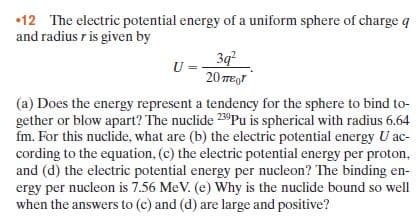•12 The electric potential energy of a uniform sphere of charge q and radius r is given by 3д U = 20 TEgr (a) Does the energy represent a tendency for the sphere to bind to- gether or blow apart? The nuclide 23°Pu is spherical with radius 6.64 fm. For this nuclide, what are (b) the electric potential energy U ac- cording to the equation, (c) the electric potential energy per proton, and (d) the electric potential energy per nucleon? The binding en- ergy per nucleon is 7.56 MeV. (e) Why is the nuclide bound so well when the answers to (c) and (d) are large and positive?
•12 The electric potential energy of a uniform sphere of charge q and radius r is given by 3д U = 20 TEgr (a) Does the energy represent a tendency for the sphere to bind to- gether or blow apart? The nuclide 23°Pu is spherical with radius 6.64 fm. For this nuclide, what are (b) the electric potential energy U ac- cording to the equation, (c) the electric potential energy per proton, and (d) the electric potential energy per nucleon? The binding en- ergy per nucleon is 7.56 MeV. (e) Why is the nuclide bound so well when the answers to (c) and (d) are large and positive?
College Physics
1st Edition
ISBN:9781938168000
Author:Paul Peter Urone, Roger Hinrichs
Publisher:Paul Peter Urone, Roger Hinrichs
Chapter28: Special Relativity
Section: Chapter Questions
Problem 56PE: A positron is an antimatter version of the electron, having exactly the same mass. When a positron...
Related questions
Question

Transcribed Image Text:•12 The electric potential energy of a uniform sphere of charge q
and radius r is given by
3д
U =
20 TEgr
(a) Does the energy represent a tendency for the sphere to bind to-
gether or blow apart? The nuclide 23°Pu is spherical with radius 6.64
fm. For this nuclide, what are (b) the electric potential energy U ac-
cording to the equation, (c) the electric potential energy per proton,
and (d) the electric potential energy per nucleon? The binding en-
ergy per nucleon is 7.56 MeV. (e) Why is the nuclide bound so well
when the answers to (c) and (d) are large and positive?
Expert Solution
This question has been solved!
Explore an expertly crafted, step-by-step solution for a thorough understanding of key concepts.
This is a popular solution!
Trending now
This is a popular solution!
Step by step
Solved in 2 steps with 2 images

Recommended textbooks for you

College Physics
Physics
ISBN:
9781938168000
Author:
Paul Peter Urone, Roger Hinrichs
Publisher:
OpenStax College

College Physics
Physics
ISBN:
9781305952300
Author:
Raymond A. Serway, Chris Vuille
Publisher:
Cengage Learning

College Physics
Physics
ISBN:
9781285737027
Author:
Raymond A. Serway, Chris Vuille
Publisher:
Cengage Learning

College Physics
Physics
ISBN:
9781938168000
Author:
Paul Peter Urone, Roger Hinrichs
Publisher:
OpenStax College

College Physics
Physics
ISBN:
9781305952300
Author:
Raymond A. Serway, Chris Vuille
Publisher:
Cengage Learning

College Physics
Physics
ISBN:
9781285737027
Author:
Raymond A. Serway, Chris Vuille
Publisher:
Cengage Learning

University Physics Volume 3
Physics
ISBN:
9781938168185
Author:
William Moebs, Jeff Sanny
Publisher:
OpenStax

Principles of Physics: A Calculus-Based Text
Physics
ISBN:
9781133104261
Author:
Raymond A. Serway, John W. Jewett
Publisher:
Cengage Learning

Physics for Scientists and Engineers with Modern …
Physics
ISBN:
9781337553292
Author:
Raymond A. Serway, John W. Jewett
Publisher:
Cengage Learning